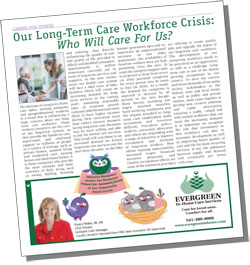By Nancy Webre, BS, MS
 The shortage of caregivers (home care aides, nursing assistants and paraprofessional workers) is a trend that is influencing a huge concern about our long-term care workforce. These workers/caregivers are the core of our long-term system, as they provide the hands-on care, supervision and emotional support to millions of people in a variety of settings, such as private homes, assisted living and residential care, nursing homes and adult foster homes. It is these caregivers who provide the most intimate and basic activities of daily living such as eating, bathing, dressing, toileting, thus directly influencing the quality of care and quality of life provided to elderly and disabled consumers. Approximately 12 million Americans currently are in need of long-term services and supports. In the next twenty years our health care system will face a tidal wave of baby boomers which will create an increasing demand for long-term services in the coming years. Assuming reasonable rates of economic growth continue, baby boomers are most likely to have higher incomes during their retirement years than today’s retirees. Boomers facing long-term care decisions may be more willing and able to pay for formal care services. This trend will contribute to an increased demand for formal long-term care services over the next three decades. As the baby boomer generation ages and we experience an unprecedented increase in our older population, the availability of frontline workers does not look promising. Over the next 20 years the caregiver support ratio is projected to drop from seven (in 2010) potential caregivers for every person over 8o years to four (in 2030). As a result, the demand for caregivers is expected to increase by 48 percent in the next decade.
The shortage of caregivers (home care aides, nursing assistants and paraprofessional workers) is a trend that is influencing a huge concern about our long-term care workforce. These workers/caregivers are the core of our long-term system, as they provide the hands-on care, supervision and emotional support to millions of people in a variety of settings, such as private homes, assisted living and residential care, nursing homes and adult foster homes. It is these caregivers who provide the most intimate and basic activities of daily living such as eating, bathing, dressing, toileting, thus directly influencing the quality of care and quality of life provided to elderly and disabled consumers. Approximately 12 million Americans currently are in need of long-term services and supports. In the next twenty years our health care system will face a tidal wave of baby boomers which will create an increasing demand for long-term services in the coming years. Assuming reasonable rates of economic growth continue, baby boomers are most likely to have higher incomes during their retirement years than today’s retirees. Boomers facing long-term care decisions may be more willing and able to pay for formal care services. This trend will contribute to an increased demand for formal long-term care services over the next three decades. As the baby boomer generation ages and we experience an unprecedented increase in our older population, the availability of frontline workers does not look promising. Over the next 20 years the caregiver support ratio is projected to drop from seven (in 2010) potential caregivers for every person over 8o years to four (in 2030). As a result, the demand for caregivers is expected to increase by 48 percent in the next decade.
Many factors, including low wages, minimal benefits, hard working conditions and the stigma attached to long-term care employment make recruitment and retention difficult. Providers, policymakers, consumer advocates and others are responding with a range of initiatives to improve recruitment and retention of long-term workers. New online training opportunities, increased wages, financial incentive programs, and creative recruitment efforts are some of the initiatives providers are offering to create quality jobs and upgrade the status of our long-term care workforce. The development of our caregiving workforce needs to be perceived as an opportunity as well as a challenge. Long-term care is one of the fastest growing occupations in our country.
To meet the current and future demands of our aging society, stakeholders at the federal, state and local levels, as well as public and private entities, must come together to develop new, creative solutions and viable alternatives ensuring a stable, valued and well trained workforce that can meet the increasing demand. It is important we recognize the role that investment in this workforce can play in economic development as well as improving better quality of care and life for those receiving services. If not, the imbalance between supply and demand will eventually get worse with time.

